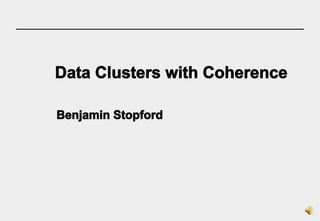The document discusses data partitioning and distribution across multiple machines in a cluster. It explains that data replication does not scale well, but data partitioning, where each record exists on only one machine, allows write latency to scale with the number of machines in the cluster. Coherence provides a distributed cache that partitions data and offers functions for server-side processing near the data through tools like entry processors.




















![All data is stored as key value pairs [key1, value1] [key2, value2] [key3, value3] [key4, value4] [key5, value5] [key6, value6]](https://image.slidesharecdn.com/datagridweb-110409065949-phpapp02/85/Data-Grids-with-Oracle-Coherence-21-320.jpg)













































